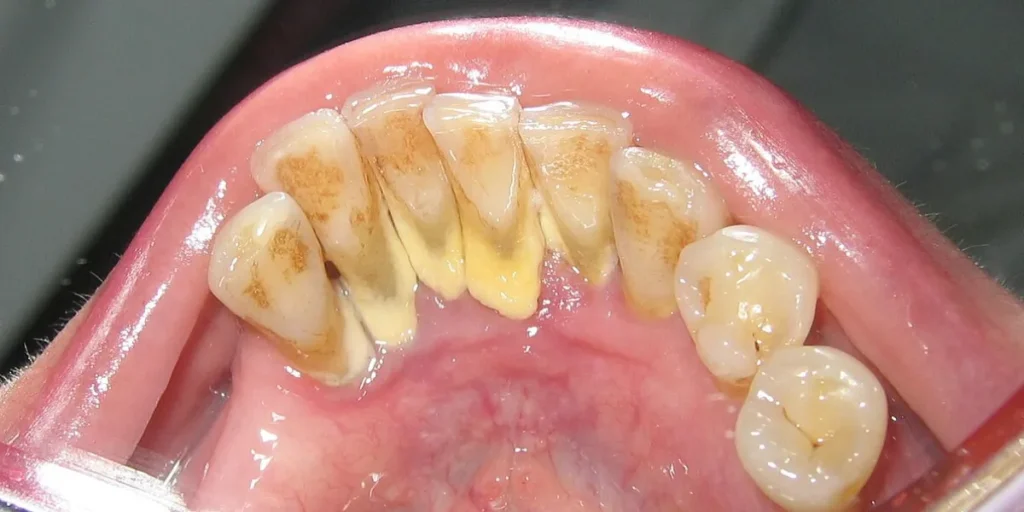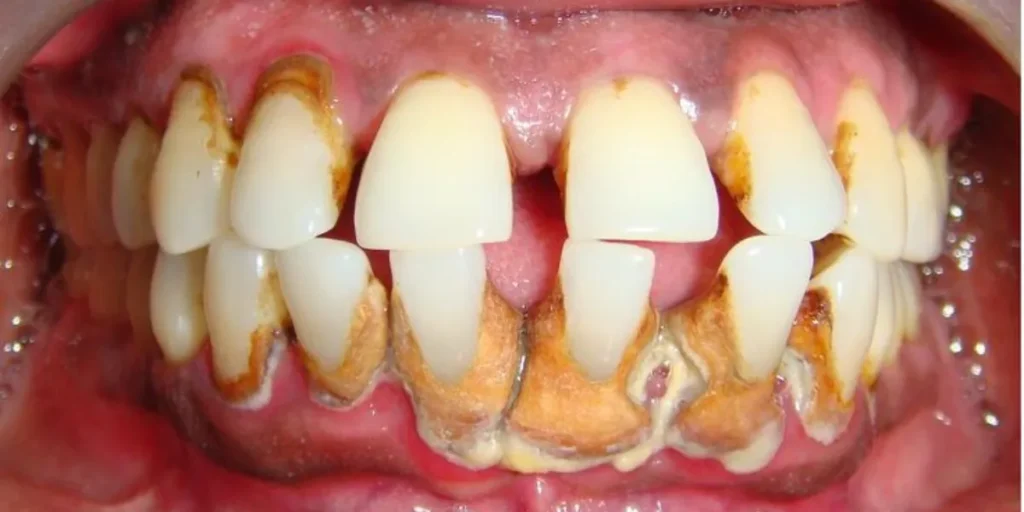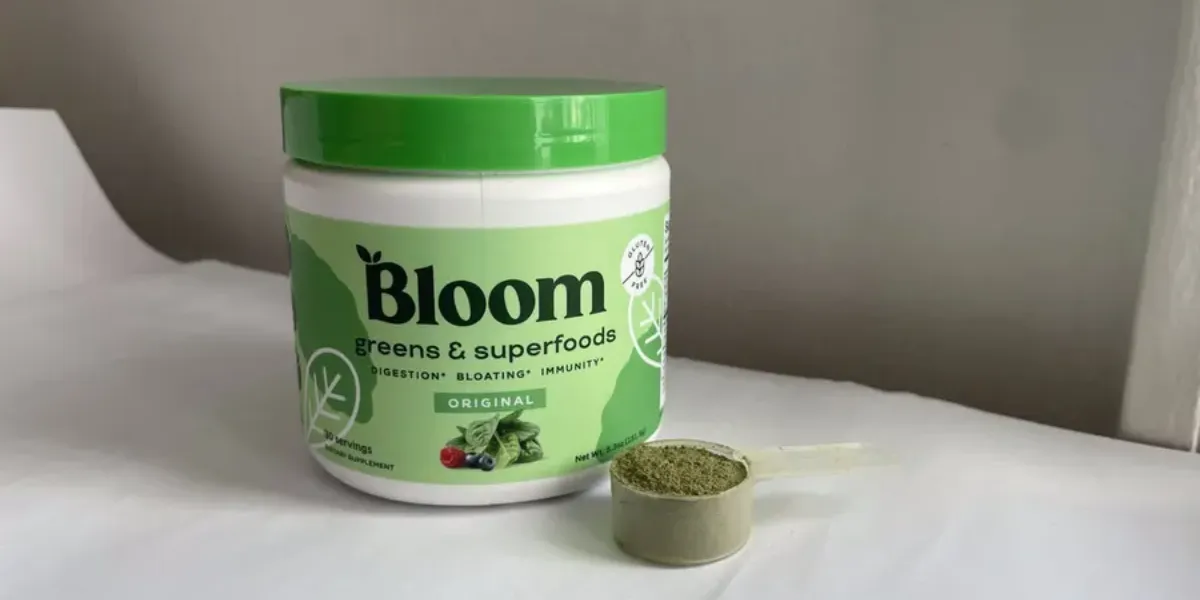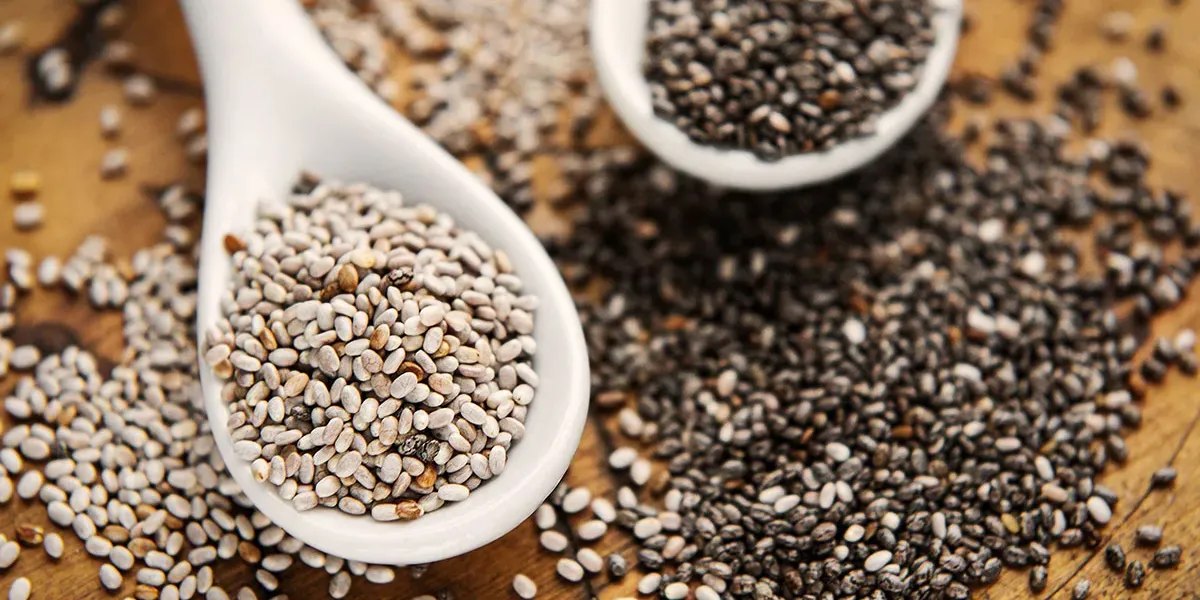In this comprehensive guide, I will walk you through everything you need to know about calculus bridges and how they affect your dental health. From prevention to care, I’ll provide you with valuable insights and tips to maintain optimal oral hygiene.
Table of Contents
ToggleUnderstanding Calculus Bridges
In this section, we’ll delve into the world of calculus bridges to gain a comprehensive understanding of what they are and how they form. By uncovering the role of dental plaque in calculus bridge development, we can take proactive steps to prevent their occurrence.
Calculus bridges, also known as tartar bridges, are hardened deposits that form on the surface of teeth and along the gumline. These deposits are a result of the mineralization of dental plaque, a thin biofilm that naturally accumulates on teeth.
Dental plaque is a sticky film comprised of bacteria, food particles, and saliva. When plaque is not sufficiently removed through regular brushing and flossing, it can harden and turn into tartar or calculus. This transformation occurs when minerals from your saliva, such as calcium and phosphate, combine with the plaque over time.
Tartar or calculus is a rough, yellowish, or brownish substance that adheres firmly to teeth, making it challenging to remove with regular oral hygiene practices. As calculus builds up, it can create a bridge-like formation between teeth, trapping bacteria and leading to various dental issues.
Several factors contribute to calculus bridge buildup, including inadequate oral hygiene, inconsistent dental care, and lifestyle choices such as smoking or consuming certain foods that promote plaque formation. Factors contributing to calculus bridge buildup:
- Poor oral hygiene practices
- Inconsistent dental care
- Consumption of sugary or starchy foods
- Smoking or tobacco use
- Dry mouth or reduced saliva flow
- Genetic predisposition
Understanding these factors and the role of dental plaque in calculus bridge formation empowers us to take proactive measures to prevent their occurrence. In the following sections, we’ll explore effective oral hygiene techniques, the impact of diet on dental health, and the importance of regular dental check-ups to maintain optimal oral health and prevent calculus bridges.
The Importance of Oral Hygiene
Proper oral hygiene is crucial when it comes to preventing calculus bridges and maintaining dental health. By adopting a thorough and consistent oral care routine, you can significantly reduce the risk of calculus bridge development. Let’s take a closer look at the different elements of a good oral hygiene routine and learn effective techniques for brushing, flossing, and mouthwashing.
Elements of a Good Oral Hygiene Routine
An effective oral hygiene routine comprises several essential elements that work together to keep your teeth and gums healthy:
- Brushing: Brush your teeth at least twice a day using a soft-bristled toothbrush and fluoride toothpaste. Make sure to clean all surfaces of your teeth, including the front, back, and chewing surfaces, using gentle circular motions. Don’t forget to brush your tongue as well to remove bacteria and freshen your breath.
- Flossing: Flossing is equally important as brushing. Use dental floss or interdental brushes to clean between your teeth and along the gumline. Glide the floss in a gentle back-and-forth motion, forming a C shape around each tooth to remove plaque and food particles that your toothbrush cannot reach.
- Mouthwashing: Incorporate mouthwash into your oral hygiene routine to further enhance dental health. Select an antimicrobial mouthwash that fights bacteria and prevents plaque buildup. Rinse your mouth thoroughly for the recommended amount of time as per the product instructions.
Effective Techniques for Brushing, Flossing, and Mouthwashing
To ensure optimal effectiveness and protect your teeth and gums, it’s important to follow proper techniques for brushing, flossing, and mouthwash:
- Brushing Technique: Hold your toothbrush at a 45-degree angle to your gumline and use short, gentle back-and-forth strokes. Brush each tooth for about two minutes, being careful not to apply excessive pressure that can damage your enamel or gums.
- Flossing Technique: Start by using about 18 inches of dental floss or interdental brush. Gently slide the floss between your teeth, curving it around each tooth and moving it up and down to remove plaque and debris. Repeat this process for each of your teeth, including the back molars.
- Mouthwashing Technique: Read the instructions provided with your mouthwash and follow the recommended duration for rinsing. Typically, it is around 30 seconds to one minute. Swish the mouthwash around your entire mouth, making sure to reach all areas, including your gums and the back of your throat. Spit out the mouthwash and avoid rinsing your mouth with water afterward to allow the active ingredients to continue working.
By incorporating these techniques into your daily oral care routine, you can effectively remove plaque, reduce calculus bridge formation, and maintain a healthy smile.
| Benefits of Proper Oral Hygiene | Consequences of Poor Oral Hygiene |
|---|---|
| ✓ Prevention of calculus bridge formation | ✗ Increased risk of calculus bridge development |
| ✓ Reduction of dental plaque buildup | ✗ Higher likelihood of gum disease |
| ✓ Fresher breath | ✗ Bad breath (halitosis) |
| ✓ Protection against tooth decay | ✗ Greater susceptibility to cavities |
As you can see, investing in proper oral hygiene practices not only helps prevent calculus bridges but also maintains overall dental health, reducing the chances of various dental problems.

Diet and its Impact on Dental Health
Your diet plays a crucial role in maintaining the health of your teeth and gums. The foods you choose to eat can either support or undermine your dental health. In this section, we’ll explore the impact of diet on dental health and discuss different foods’ effects on plaque formation. I’ll also provide recommendations on tooth-friendly foods that can help prevent the formation of calculus bridges.
Plaque, which is a sticky film of bacteria, can form on your teeth when you consume certain foods and beverages. Over time, if not properly removed, plaque can harden into tartar or calculus, leading to dental issues such as gum disease and tooth decay.
The Role of Diet in Plaque Formation
When it comes to plaque formation, certain types of foods and beverages can significantly contribute to the buildup of plaque on your teeth. These include:
- Sugary and Sticky Foods: Consuming foods high in sugar, such as candies, cookies, and sodas, can provide an ideal environment for plaque-causing bacteria to multiply. Sticky foods, like dried fruits and caramel, can also cling to your teeth, making it harder to remove plaque.
- Acidic Foods and Drinks: Acidic foods and beverages, such as citrus fruits, tomatoes, and carbonated drinks, can erode the tooth enamel, making it more susceptible to plaque formation.
- Carbohydrates: Foods rich in carbohydrates, such as bread, pasta, and chips, can break down into sugars that bacteria in your mouth feed on, leading to plaque formation.
Tooth-Friendly Foods for Preventing Calculus Bridges
Luckily, there are also plenty of tooth-friendly foods that can help prevent the formation of calculus bridges and promote dental health. These include:
- Fresh Fruits and Vegetables: Crispy fruits and vegetables, like apples, celery, and carrots, have a natural cleansing effect on your teeth. Chewing them stimulates saliva production, which helps wash away plaque-causing bacteria.
- Calcium-Rich Foods: Dairy products, such as milk, cheese, and yogurt, are excellent sources of calcium, which promotes strong teeth and jawbones. Consuming these foods can help prevent tooth decay and maintain dental health.
- Green and Black Tea: These teas contain compounds that can reduce oral bacteria growth and suppress the formation of plaque. Drinking tea without added sugar or sweeteners can be a great choice for maintaining dental health.
By incorporating tooth-friendly foods into your diet and limiting the consumption of plaque-promoting foods, you can significantly improve your dental health and reduce the risk of calculus bridge formation. Remember to combine a healthy diet with good oral hygiene practices, such as regular brushing, flossing, and visits to your dentist, for optimal results.
| Tooth-Friendly Foods | Foods That Promote Plaque Formation |
|---|---|
| Fresh fruits and vegetables (e.g., apples, celery, carrots) | Sugary and sticky foods (e.g., candies, cookies, dried fruits) |
| Calcium-rich foods (e.g., milk, cheese, yogurt) | Acidic foods and drinks (e.g., citrus fruits, carbonated drinks) |
| Green and black tea (unsweetened) | Carbohydrates (e.g., bread, pasta, chips) |
Regular Dental Check-ups and Cleanings
When it comes to maintaining a healthy smile and preventing calculus bridges, regular dental check-ups and cleanings are of utmost importance. As a dental professional, I can’t emphasize enough the significance of these routine visits in keeping your teeth and gums in optimal condition.
During your dental check-up, your dentist will not only assess your oral health but also thoroughly clean your teeth, removing any plaque and calculus buildup. This thorough cleaning is essential in preventing the formation of calculus bridges, which can lead to gum disease, tooth decay, and other oral health issues.
But how often should you schedule these dental visits? The frequency of dental check-ups may vary depending on your specific oral health needs and risk factors. In general, it is recommended to visit your dentist at least twice a year for check-ups and cleanings. However, some individuals may require more frequent visits, especially if they have a history of calculus bridge formation or other dental issues.
Remember, prevention is the key to maintaining a healthy smile. By scheduling regular dental check-ups and cleanings, you can nip potential problems in the bud and address any early signs of oral health issues.
The Benefits of Regular Dental Check-ups:
- Early detection of dental problems
- Removal of plaque and calculus buildup
- Prevention of gum disease
- Thorough examination of your oral health
- Evaluation of dental hygiene practices
| Age Group | Recommended Dental Visit Frequency |
|---|---|
| Children (0-12 years) | Every 6 months |
| Teenagers (13-19 years) | Every 6-12 months |
| Adults (20-64 years) | Every 6-12 months |
| Seniors (65+ years) | Every 3-6 months |
Please note that these are general recommendations, and your dentist may suggest more frequent visits based on your individual needs.
By prioritizing regular dental check-ups and cleanings, you are taking a proactive approach to your oral health. Remember, prevention and early intervention are key to avoiding complex and costly dental procedures down the road. Take care of your smile, and it will take care of you!
Effective Techniques for Plaque Removal
Are you curious about the best approaches for removing plaque buildup at home? In this section, I’ll provide step-by-step instructions for effective plaque removal, including the use of dental tools and aids. Following these techniques will minimize the chances of calculus bridge formation.
1. Brushing Techniques
Brushing your teeth properly is paramount in removing plaque. Here are the essential steps to follow:
- Select a soft-bristled toothbrush and apply a pea-sized amount of fluoride toothpaste.
- Hold the toothbrush at a 45-degree angle to your gumline.
- Use gentle circular motions to brush each tooth thoroughly, paying extra attention to the gumline.
- Brush the outer, inner, and chewing surfaces of your teeth.
- Don’t forget to brush your tongue to remove bacteria and freshen your breath.
- Rinse your mouth with water after brushing.
2. Flossing Techniques
Flossing is an essential step in plaque removal, as it reaches areas that your toothbrush cannot. Here’s how to floss effectively:
- Take about 18 inches of dental floss and wrap it around your middle fingers.
- Hold the floss tightly between your thumbs and forefingers.
- Gently insert the floss between your teeth.
- Curve the floss into a C-shape and glide it up and down each tooth, including the gumline.
- Use a clean section of the floss for each tooth.
- Rinse your mouth with water after flossing.
3. Mouthwashes and Rinses
In addition to brushing and flossing, using mouthwashes and rinses can supplement your plaque removal routine. Look for antimicrobial mouthwashes that kill plaque-causing bacteria and freshen your breath. Rinse your mouth for the recommended time as stated on the product label.
4. Interdental Cleaners
Interdental cleaners, such as interdental brushes and water flossers, can be used alongside brushing and flossing to remove plaque from difficult-to-reach areas. These aids can effectively clean between teeth and along the gumline, reducing the risk of plaque buildup.
| Plaque Removal Techniques | Effectiveness |
|---|---|
| Brushing (using proper techniques) | High |
| Flossing | High |
| Mouthwashes and rinses | Moderate |
| Interdental cleaners | Moderate |
By incorporating these effective plaque-removal techniques into your dental care routine, you can maintain a healthy and plaque-free smile. Remember, consistent and thorough oral hygiene practices are the key to preventing calculus bridge formation and maintaining optimal dental health.
Treating Calculus Bridges
If calculus bridges have already formed, it is crucial to seek professional treatment to prevent further complications. There are various dental procedures available for treating calculus bridges, including:
- Scaling: This procedure involves the removal of plaque and tartar from the tooth surfaces above and below the gumline. A specialized dental instrument is used to gently scrape away the buildup, ensuring a clean and smooth surface.
- Root Planing: Root planing is performed when there is a calculus buildup deep below the gumline. The dentist or dental hygienist will carefully clean the roots of the affected teeth, smoothing out any rough spots and eliminating bacteria. This procedure helps prevent further progression of gum disease.
- Antibiotics: In some cases, your dentist may prescribe antibiotics to control bacterial growth and infection associated with calculus bridge buildup. Antibiotics can be taken orally, applied topically, or delivered directly into the affected area, depending on the severity of the condition.
Each treatment option aims to remove the calculus bridge and restore your dental health. Your dentist will determine the most suitable approach based on the severity of the calculus bridge and your overall oral health. It’s important to follow your dentist’s recommendations and continue practicing good oral hygiene to prevent future calculus bridge formation.
Maintaining Oral Health at Home
Beyond preventing calculus bridges, maintaining overall oral health is crucial. To ensure your teeth and gums stay in optimal condition, it is essential to develop a daily care routine that goes beyond brushing and flossing. In this section, I will provide you with practical advice and tips on how to effectively maintain your oral health at home.
Tips for Tongue Scraping
Tongue scraping is an often overlooked but important aspect of oral hygiene. By gently scraping your tongue, you can remove bacteria, food debris, and dead cells that accumulate on its surface. This not only helps freshen your breath but also reduces the risk of developing oral health issues.
- Use a tongue scraper, which is typically made of plastic or metal.
- Starting from the back of your tongue, gently scrape forward in a sweeping motion.
- Rinse the scraper after each scrape to remove the residue.
- Repeat this process 2-3 times a day, preferably after brushing your teeth.
Gum Massages for Gum Health
Gum massages are an excellent way to improve blood circulation in your gums and maintain their health. Regular gum massages can help prevent gum diseases, such as gingivitis, and promote optimal oral well-being.
- Wash your hands thoroughly before proceeding with the gum massage.
- Using your index finger, gently rub your gums in a circular motion.
- Apply slight pressure but avoid excessive force that may cause discomfort or pain.
- Massage each section of your gums for about 1-2 minutes.
- Repeat the gum massage at least once a day, preferably after brushing and flossing.
Optimizing Mouthwash Usage
Mouthwash can be a valuable addition to your daily oral hygiene routine, but it’s important to use it correctly to reap its benefits fully. Here are some tips to optimize your mouthwash usage:
- Choose an alcohol-free mouthwash to avoid drying out your mouth.
- Pour the mouthwash into the cap to measure the appropriate amount.
- Swish the mouthwash around your mouth for about 30 seconds to 1 minute.
- Do not swallow the mouthwash; spit it out after swishing.
- Wait at least 30 minutes after using mouthwash before eating or drinking.
- Use mouthwash once or twice a day, preferably after brushing and flossing.
Your Daily Care Routine
| Step | Activity |
|---|---|
| 1 | Brushing your teeth |
| 2 | Flossing |
| 3 | Tongue scraping |
| 4 | Gum massages |
| 5 | Mouthwash usage |
Following this daily care routine will ensure that you are taking the necessary steps to maintain your oral health and prevent calculus bridges. Incorporating these additional practices into your daily routine will help promote healthy teeth, gums, and overall oral hygiene.
Common Dental Problems Associated with Calculus Bridges
When calculus bridges are left untreated, they can lead to various dental problems that can significantly impact your oral health. It’s essential to understand these potential complications so you can take the necessary steps to prevent or seek early treatment. Let’s explore some common dental issues that can arise from calculus bridge buildup:
Gum Inflammation
One of the most common problems associated with calculus bridges is gum inflammation, also known as gingivitis. The accumulation of plaque and tartar around the teeth and gums can irritate the gum tissues, causing redness, swelling, and tenderness. If left untreated, gingivitis can progress to a more severe form of gum disease.
Bad Breath
Calculus bridges provide an ideal environment for bacteria to flourish, leading to persistent bad breath or halitosis. The bacteria produce volatile sulfur compounds that cause an unpleasant odor. Good oral hygiene, including regular brushing, flossing, and professional cleanings, can help eliminate bad breath caused by calculus bridges.
Tooth Decay
When calculus bridges are present, they can make it difficult to effectively clean the teeth, leading to an increased risk of tooth decay. The tartar buildup provides a haven for bacteria, which produce acids that erode tooth enamel and lead to cavities. Regular dental check-ups and proper oral hygiene can help prevent tooth decay.
| Dental Problem | Description |
|---|---|
| Gum Inflammation (Gingivitis) | Redness, swelling, and tenderness of the gums caused by plaque and tartar buildup |
| Bad Breath (Halitosis) | Persistent unpleasant odor caused by bacterial growth on calculus bridges |
| Tooth Decay (Cavities) | Erosion of tooth enamel due to acids produced by bacteria on calculus bridges |
These dental problems associated with calculus bridges highlight the importance of preventive measures and early treatment. Maintaining good oral hygiene, scheduling regular dental check-ups, and seeking professional cleanings can help prevent the formation of calculus bridges and mitigate their adverse effects on your dental health.
Dental Health for Different Age Groups
Dental health needs can vary across different age groups. It’s important to understand the unique dental care requirements for children, teenagers, adults, and seniors. By providing age-appropriate dental care advice, we can ensure optimal oral health throughout each stage of life.
Dental Care for Children
Children require special attention when it comes to dental health. Here are some key considerations:
- Starting early: It’s important to begin oral hygiene practices as soon as the first teeth appear. Use a soft-bristled toothbrush and a rice grain-sized amount of fluoride toothpaste.
- Regular dental visits: Introduce your child to regular dental check-ups by their first birthday. This allows the dentist to monitor development and provide guidance.
- Sealants and fluoride treatments: These preventive measures can protect your child’s teeth from decay and cavities.
Dental Care for Teenagers
Teenagers face unique dental challenges due to hormonal changes and lifestyle factors. Here are some tips aimed specifically at their dental health:
- Brushing and flossing: Encourage teenagers to maintain a consistent daily oral hygiene routine, including brushing at least twice a day and flossing regularly.
- Dietary choices: Limit sugary snacks and drinks to reduce the risk of tooth decay. Encourage healthier eating habits and drinking plenty of water.
- Mouthguards: If your teenager plays sports, ensure they use a mouthguard to protect their teeth and jaw during physical activities.
Dental Care for Adults
Adults need to prioritize dental health to maintain healthy teeth and gums throughout their lives. Here are some recommendations:
- Oral hygiene routine: Brush your teeth at least twice a day with fluoride toothpaste, floss daily, and use mouthwash to maintain optimal oral hygiene.
- Healthy diet: Eat a balanced diet, limiting sugary and acidic foods and drinks that can harm your teeth and contribute to plaque formation.
- Regular dental check-ups: Visit your dentist every six months for professional cleanings, examinations, and early detection of any dental issues.
Dental Care for Seniors
As we age, dental health becomes even more important. Here are some key considerations for seniors:
- Oral hygiene: Continue to brush and floss regularly. Use a toothbrush with soft bristles to prevent gum irritation.
- Denture care: If you wear dentures, clean them regularly and ensure a proper fit to maintain oral health.
- Regular dental visits: Schedule dental check-ups at least twice a year to address any oral health concerns and monitor the condition of your teeth and gums.
| Age Group | Key Dental Care Tips |
|---|---|
| Children | Follow a strict oral hygiene routine, maintain a healthy diet, and visit the dentist regularly. |
| Teenagers | Maintain a consistent oral hygiene routine, make healthy dietary choices, and use mouthguards. |
| Adults | Continue good oral hygiene practices, take care of dentures, and attend regular dental check-ups. |
| Seniors | Continue good oral hygiene practices, take care of dentures, attend regular dental check-ups. |
Lifestyle Factors and Dental Health
Certain lifestyle choices can have a significant impact on your dental health and increase the risk of calculus bridge development. It’s important to be aware of these lifestyle factors and understand their effects on your oral well-being. By recognizing the potential risks, you can make positive choices that promote a healthier smile.
Smoking and Dental Health
Smoking not only harms your overall health but also has detrimental effects on your dental well-being. It is a leading risk factor for oral diseases, including gum inflammation, tooth decay, and periodontal disease. The chemicals in tobacco products can damage gum tissue, weaken the immune system, and hinder the healing process in the mouth. If you are a smoker, quitting or reducing your smoking habit is crucial for maintaining optimal dental health.
Excessive Alcohol Consumption and Dental Health
Excessive alcohol consumption can also negatively impact your dental health. Alcohol is acidic and can erode tooth enamel, leading to increased tooth sensitivity and a higher risk of tooth decay. It can also contribute to dry mouth, which reduces saliva production and makes your teeth more susceptible to cavities. Limiting your alcohol intake and practicing moderation will help protect your teeth and gums.
Stress and Dental Health
When it comes to your dental health, managing stress is essential. Stress can manifest in various ways and affect your oral health. It can lead to teeth grinding, jaw clenching, and other oral habits that can damage your teeth. Additionally, stress weakens the immune system, making it harder for your body to fight off oral infections and gum disease. Implementing stress management techniques, such as exercise, meditation, and therapy, can support good dental health.
Summary
By understanding the impact of lifestyle factors on dental health, you can take proactive steps to protect your smile. Avoiding smoking, moderating alcohol consumption, managing stress, and adopting a healthy lifestyle can significantly reduce the risk of calculus bridge development and promote overall oral well-being.
Conclusion
Thank you for joining me on this journey to understanding dental health and calculus bridges. Throughout this guide, we have explored the formation of calculus bridges and learned how to prevent them. By implementing consistent oral hygiene practices, such as brushing, flossing, and mouthwashing, you can maintain optimal oral health and reduce the risk of calculus bridge development.
Regular dental check-ups and cleanings are essential for removing plaque and calculus buildup. By scheduling routine visits with your dentist, you can address any potential issues early on and receive professional care tailored to your needs. Remember, prevention is always better than treatment.
As you continue your dental health journey, keep in mind that your diet and lifestyle choices play crucial roles. Consuming tooth-friendly foods and avoiding habits like smoking and excessive alcohol consumption can significantly contribute to maintaining a healthy smile.
Now armed with the knowledge and tips provided in this guide, you have the tools necessary to prioritize your dental health. By incorporating these practices into your daily routine and committing to regular dental care, you can enjoy a vibrant smile and improve your overall well-being.
FAQ
What are calculus bridges?
Calculus bridges are hard deposits of dental plaque that form on the teeth and gum line. They are made up of minerals from saliva, food particles, and bacteria, and can cause various dental problems if not addressed.
How do calculus bridges form?
Calculus bridges form when dental plaque, a sticky film of bacteria, builds up on the teeth and hardens over time. This plaque is often caused by inadequate oral hygiene practices and can lead to the formation of calculus bridges.
How can I prevent calculus bridges?
To prevent calculus bridges, it is essential to practice good oral hygiene. This includes brushing your teeth at least twice a day, flossing daily, and using an antiseptic mouthwash. Regular dental check-ups and cleanings are also crucial for removing plaque and preventing calculus bridge formation.
What is the importance of oral hygiene in preventing calculus bridges?
Maintaining proper oral hygiene is crucial in preventing calculus bridges. By brushing and flossing regularly, you can remove dental plaque, the primary cause of calculus bridge formation. Regular professional cleanings are also necessary to remove any hardened calculus and keep your teeth and gums healthy.
Does diet affect calculus bridge formation?
Yes, diet can impact calculus bridge formation. Consuming foods high in sugar and carbohydrates can contribute to plaque buildup, which increases the risk of calculus bridge formation. It is important to maintain a balanced diet and limit the intake of sugary and acidic foods to promote good oral health.
How often should I visit my dentist to prevent calculus bridges?
It is recommended to visit your dentist every six months for routine check-ups and cleanings. These visits allow your dentist to monitor your oral health, remove any plaque or calculus buildup, and detect any early signs of potential dental problems, including calculus bridges.
Are there any effective techniques for removing plaque at home?
Yes, there are several effective techniques for removing plaque at home. These include using a soft-bristled toothbrush and toothpaste with fluoride, flossing daily, and incorporating the use of dental tools like interdental brushes or water flossers. Consult with your dentist to determine the best plaque removal techniques for your specific needs.
What are the treatment options for calculus bridges?
If calculus bridges have already formed, professional dental treatment is necessary. Common treatment options for calculus bridges include scaling and root planing, which involves removing the hardened calculus deposits from the teeth and beneath the gum line. Your dentist will recommend the most suitable treatment plan based on your dental condition.
What can I do to maintain optimal oral health at home?
In addition to regular brushing, flossing, and dental check-ups, there are several things you can do to maintain optimal oral health at home. These include tongue scraping to remove bacteria, performing gum massages to improve circulation, and using mouthwash to freshen your breath and kill bacteria. Your dentist can provide further guidance on a personalized daily care routine.
What dental problems can be associated with calculus bridges?
Calculus bridges can lead to various dental problems if left untreated. These problems include gum inflammation (gingivitis), bad breath (halitosis), tooth decay, and even gum disease (periodontitis). It is crucial to address calculus bridge formation promptly to prevent these complications.
How does dental health differ across different age groups?
Dental health needs can vary across different age groups. Children may require extra attention to oral hygiene and guidance on proper brushing techniques, while teenagers might need education on the impact of diet and lifestyle choices. Adults and seniors may face challenges such as tooth loss or denture care. It is essential to consider age-specific dental care practices to maintain optimal oral health throughout life.
How do lifestyle factors affect dental health and calculus bridge formation?
Certain lifestyle factors like smoking, excessive alcohol consumption, and high stress levels can have detrimental effects on dental health and increase the risk of calculus bridge formation. These habits can contribute to dry mouth, hinder saliva production, and compromise the body’s ability to fight bacteria, leading to oral health issues. It is important to be aware of these factors and make positive choices for overall oral well-being.










